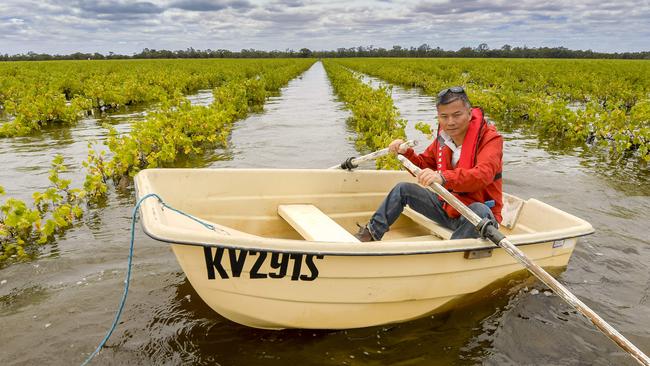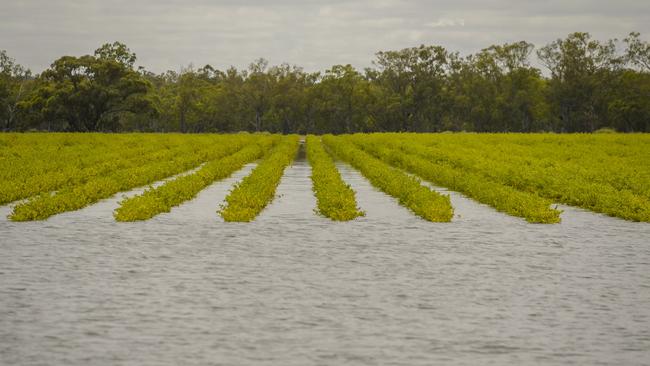Murray floodwaters wash away dreams as vineyards inundated
The white wine grapes growing on Meiqing Lin’s vineyard were supposed to fund the diversification of his business, but only the tops of the vines are visible above the water that poured in from the swollen Murray River.

The white wine grapes growing on Meiqing Lin’s vineyard in Renmark, South Australia, were supposed to fund the diversification of his business after it was crippled by China’s trade war.
But for the past week, only the tops of the vines have been visible above the water that poured in from the swollen Murray River.
Inspecting the vines aboard a small dinghy, Mr Lin knows it is unlikely they will survive the inundation, which is expected to last months.
“For the 2023 vintage, I still had strong demand for my white grapes and white wine,” Mr Lin said. “This was going to help me finance and establish new export markets in Southeast Asia. Now I won’t have any grapes or wine to sell from the 2023 vintage.”
As the water wound its way down the river in November and early December, Mr Lin tried to shore up the levee bank built to protect his vines. But the levee failed on December 5 and the river came rushing in.
Within 12 hours, 1.5m of water sat over the 81ha vineyard.
“Now my vineyard is at the risk of dying if the water is not removed,” Mr Lin said.
He’s been trying to find support from the local council to rebuild the levee and pump the water out of his property.
Mr Lin is not alone in his predicament. It is estimated that more than 40 vineyards in the Riverland district near the South Australia Victoria border have been inundated.
While most vineyards in the region are located above the flood plain, modelling has shown that if the river reaches a flow of 250 gigalitres a day, more than 180 growers will be affected.
Riverland Wines executive officer Lyndall Rowe said the flood had exceeded 1974 and 1931 levels, but was still below the record 1956 height.
“All you can see on some vineyards is the tops of the vines,” Ms Rowe said.
“If it stays like that the roots will drown and they will have to replant the vines.”
Replanted vines would take two years to bear fruit, further exacerbating already tough conditions for growers.
“The flood is one crisis on top of a much bigger crisis facing the industry,” Ms Rowe said.
Chinese tariffs on Australian wine imports two years ago put an immediate halt on the region’s primary market.
Mr Lin said the tariff had caused a significant drop in wine sales. “We need to find new markets, which will take a long time,” he said.
It will likely involve planting new grape varieties to meet the tastes of consumers outside of China.

Riverland growers, who produce about a third of Australia’s wine, had for decades tailored their vineyards to specifically meet the demands of the Chinese market and to provide the massive quantities needed.
Increased transport costs and inflation have made Australian wine temporarily uncompetitive in the global commercial wine market and Riverland wines do not have established domestic customers.
“We produce quality wine for a particular market and that market isn’t there at the moment,” Ms Rowe said. “Riverlands growers and producers know that they need to transition and diversify, but they need support to do that.”
While some growers have transitioned to other crops such as almonds, others are grafting their shiraz and cabernet vines with lighter, fruitier varieties.
But it is an expensive exercise and the sudden loss of income from the Chinese tariffs, and now the flooding, have made a difficult task almost impossible for some growers.
The industry has called for a $5m government package to help find new markets and to assist growers transition to new crops.
Federal Agriculture Minister Murray Watt visited the region last week and said that the government would consider “additional support” for flood-affected primary producers on top of the grants and low-interest loans already available.








To join the conversation, please log in. Don't have an account? Register
Join the conversation, you are commenting as Logout